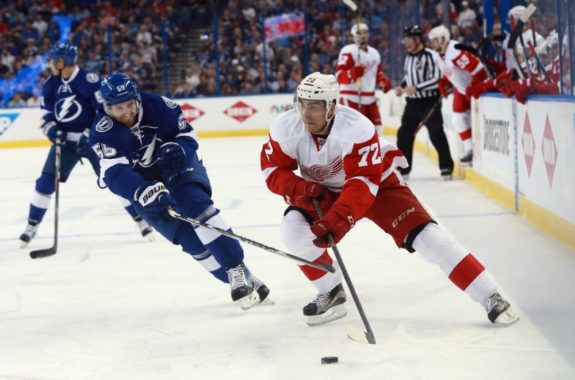Believe it or not, Detroit Red Wings fans, coach Jeff Blashill does believe in analytics — but he doesn’t put a lot of stock in them.
Blashill was at the Detroit Economic Club on Monday, taking questions from the audience on topics ranging from analytics to tips for parents dealing with young athletes.
When an audience member asked the second-year Red Wings coach about analytics, he had this to say:
“I think hockey is very different than baseball. And I think the NHL as a whole is trying to come up with measurables that are valuable, measurables that you can actually utilize to help you make decisions.
Right now, I don’t think a lot of the analytics out there are really very deep. They’re really just different stats, in my mind. They’re not deeper stats. They’re not giving us a whole bunch more information, especially if they’re just taken as one.”
Blashill isn’t 100 percent wrong with his answer, but he is missing the bigger picture when it comes to advanced stats.
Zone Starts

One of the stats Blashill spoke about as being overrated is Fenwick, which is shot attempts on goal and missed. It differs from Corsi, which includes blocked shots. Blashill had this to say about Fenwick:
“If you talk lots about Fenwick, it matters what zone that player starts in a lot. And, if you don’t combine those two metrics together, you don’t get a whole lot out of it.
What we’ve tried to do is create some internally. We’re not different from any other NHL team. We’re all trying to create internal measurables that we use in the decision-making processes.”
Again, Blashill isn’t 100 percent wrong but is right about one thing. Fenwick, or any other advanced stat for that matter, is worthless by itself. A player with a Corsi or Fenwick for percentage greater than 50 isn’t automatically a great player. And likewise, a player with a CF% or FF% of less than 50 isn’t automatically a bad player. More information needs to be gathered as to why that player is performing well or poorly. Is it the teammates he plays with? Is it the competition he faces? Is he out on the ice when his team is trailing or leading? There are a number of factors that can influence the game, and hockey by itself is full of randomness and hard to quantify.
Key takeaway: the way we measure zone starts right now is waaaaaaaaaaay off. pic.twitter.com/y8FCUfM5AG
— Matt Cane (@Cane_Matt) January 16, 2015
Blashill spoke about how important zone starts are in relation to Fenwick, however, zone starts don’t matter as much as initially thought. Matt Cane, a writer for Hockey Graphs and Puck Plus Puck wrote two articles on how zone starts do not matter as much as we used to think. Part I defines true zone start percentage, which takes shifts started on the fly into account, and Part II looks at how a player’s zone start percentage is affected by his performance, meaning bad players end up in their own zone because they are unable to drive play and, therefore, end up taking more defensive zone faceoffs.
In regards to true zone percentage, Cane found about 60 percent of the average players’ shifts started on the fly. Taking this into account, he found the average player started about 10 percent of their shifts in the defensive zone, about 18 percent in the neutral zone and 12 percent in the offensive zone.
So, when Blashill said zone starts affect Fenwick, there is some truth to that, but the reality is an overwhelming majority of shifts start on the fly, and defensive, neutral and offensive zone starts have very little effect on Fenwick by themselves.
Also, most advanced sites, such as Corsica and Natural Stat Trick, have score, zone and venue adjustments which alter a player’s stats based on the score, zone or arena they play in. So again, Blashill’s critique isn’t completely wrong, but it isn’t as simple as saying zone starts matter.
‘Internal Measurables’

Blashill did mention the team tracks stats internally, which is a great way of attempting to get a leg up on the competition. It’s unfortunate he didn’t expand on that more — I’m guessing he doesn’t want other teams knowing what stats they track — but I am curious as to what these stats are.
I know I’ve heard him speak about scoring chances on Fox Sports Detroit broadcasts before, but that is a stat featured on most advanced stats sites, so it’s not really a big secret. Plus, scoring chance is such a subjective term. Unless you have a strict definition of what does or does not make a scoring chance, those could vary from team to team.
I am curious if the Red Wings pay attention to rate stats. Rate stats measure how much a player is performing at a 60-minute rate. I already discussed how point per game stats can be deceiving because some players get more ice time than other players do. Andreas Athanasiou’s 0.47 points per game at five on five mark doesn’t look all that impressive, but his points per 60 is 2.67, according to Corsica, which is top 10 in the NHL. In fact, he is top 10 in goals per 60 and primary points per 60, as well.
So, Athanasiou is a perfect example of a player with a score-adjusted Corsi for percentage of less than 50 (48.8), which is not good, but his rate stats are some of the best in the league, which is obviously very good for a rookie. It shows he needs to improve the defensive part of his game, but he is an offensive force and should be getting more than 10.5 minutes per night at five-on-five.
Deep Analytics
When Blashill said analytics aren’t deep, that’s true of each stat individually. Corsi and Fenwick simply are shot attempts and don’t tell the whole story. But if you couple that with rate stats, relative stats, scoring chances and expected stats, there is a deep rabbit hole you can go down that will tell you a lot about how a player plays.
Plus, there are a number of people tracking micro stats that continue to give us more insight into how good or bad a player is. There is a forechecking project, a passing project, a special teams project and numerous other stats that attempt to give us more information.
Of course, that’s not to say advanced stats should replace scouting. The stats show what happened, scouting tells how it happened.
Blashill knows there are limits to advanced stats, and that is a step in the right direction. However, to say they are not deep is oversimplifying them and their use.